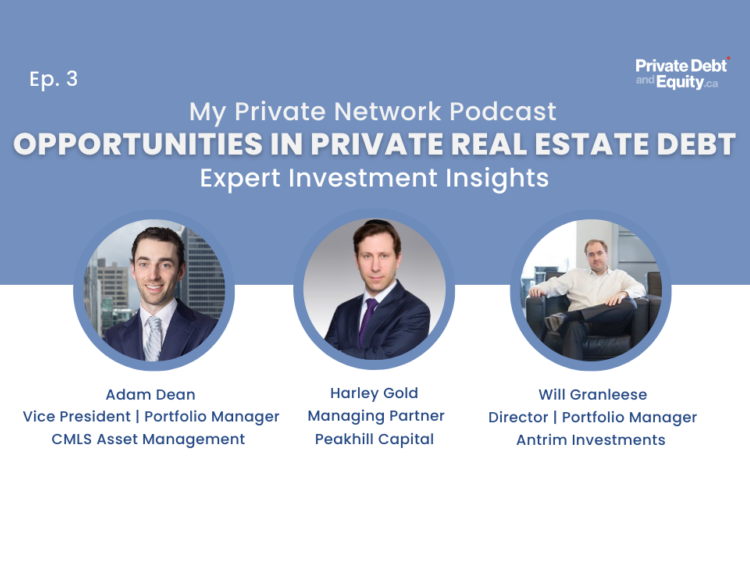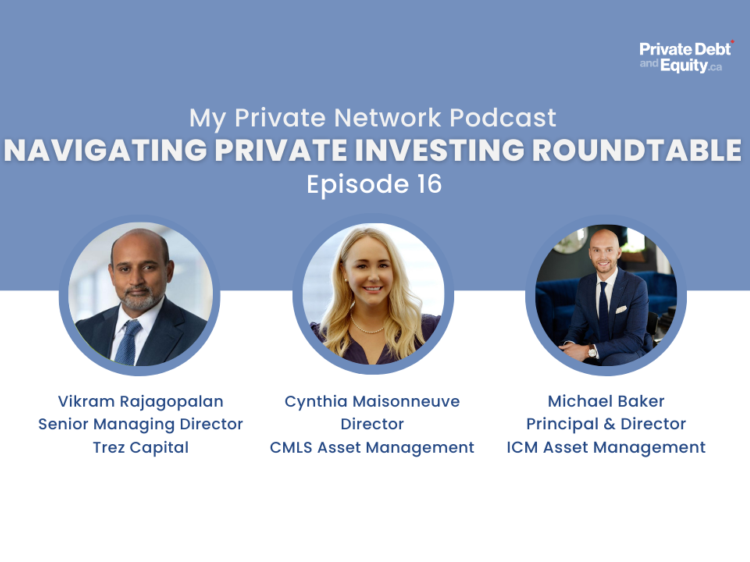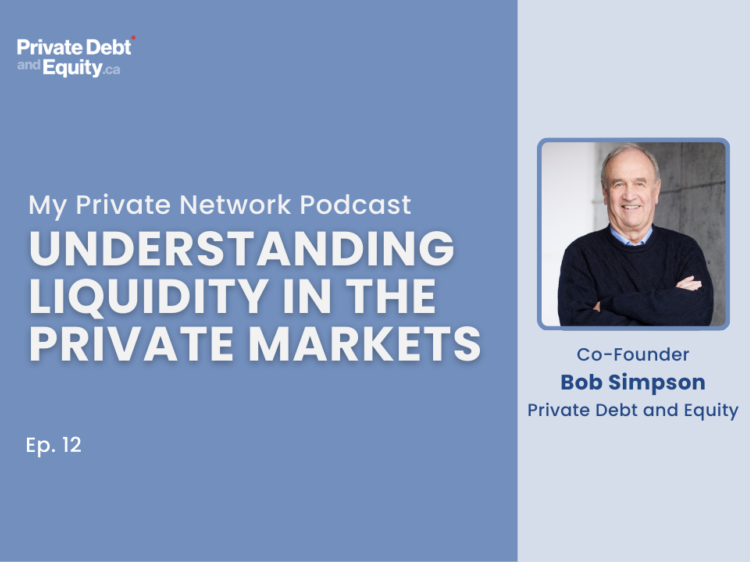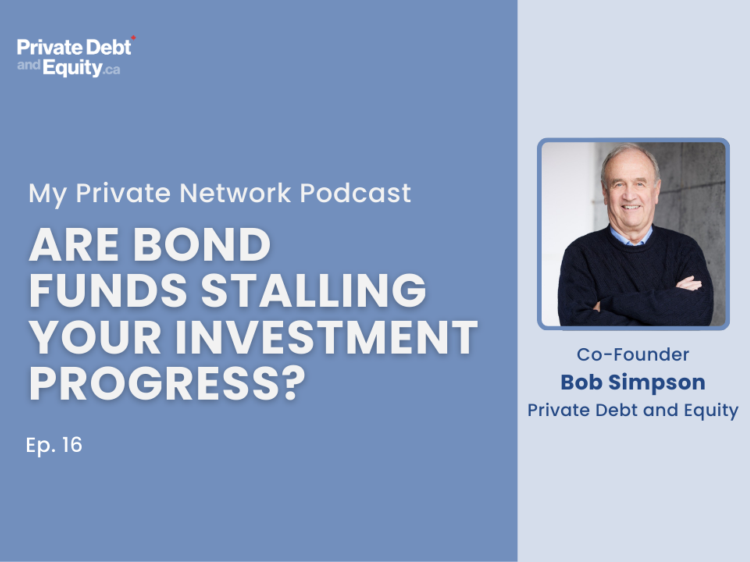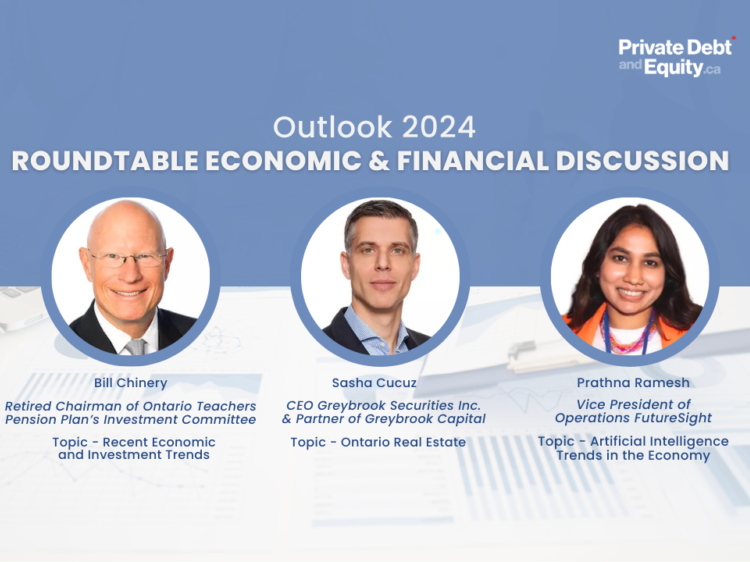Welcome to the My Private Network Podcast!
Interested in learning about private market investing concepts and opportunities available to you?
This week's episode features our co-founder and host, Bob Simpson, who gives you, the investor, a chance to hear from industry experts about why you should consider investing in private real estate?
Our expert panelists with "boots on the ground" experience in the private markets:
Kent Willmore
President and CEO
AGInvest Properties Canada Inc.
Geoff Lang
Senior Vice President
Equiton
Vikram Rajagopalan
Senior Managing Director, Capital Strategy and Distribution
Trez Capital
Gabriel Millard
Managing Partner
Avenue Living
Aly Damji
Managing Partner
Forum Asset Management
Today's Questions of Interest
02:22 Why should investors consider farmland as an asset class for their portfolio?
06:21 Why invest in private real estate, could you summarise what multi-family is and the opportunities available?
09:47 Why does your firm like Texas and what are some of the key opportunities in that market?
12:22 Could you tell me about investing in public storage?
18:12 Could you give us some reasons why investors should consider allocating part of their portfolios to purpose-built student accommodations?
Transcript
Bob Simpson: I'm Bob Simpson, your host and co-founder of privatedebtandequity.ca, a website to educate investors about concepts and opportunities in private markets. Now, unfortunately, we don't have a skip recap or skip the intro button like they do on Netflix. So I'm going to keep it fairly short today. In episode one, we opened the doors to five people in my private network to answer the question, why allocate funds to private debt?
Each of our guests will be back to discuss their private debt and equity concept in much more detail in future episodes. Now, today we're gonna follow a similar path to episode one, but we're gonna dive deeply into the question "Why allocate funds to private equity?" with a focus on real estate. Once again, I have assembled a group of experts in a broad range of specialties within the private real estate asset class.
Vikram Rajagopalan is our only returning panelist today as his expertise overlaps, both private debt and private real estate investing. Also joining us today on the panel are Geoff Lang, Gabriel Millard, Kent Wilmore, and Aly Damji. Everything from farmland to self storage to student housing, from building housing communities and apartment buildings in Ontario, to buying and renovating apartment buildings and even build to rent communities in Texas.
Now, it sounds like we have a busy schedule today. So let's keep it informative, but let's keep it simple. The doors to my private network are opening. Let's see what we can learn today. We've got about 30 minutes. So let's dive right into our rapid fire short responses.
I'm going to start with Kent Wilmore. Kent. Farmland. Give us an overview. Why should investors consider farmland as an asset class in their portfolio?
Kent Willmore: Yeah, thank you for asking that question. So farmland is a really unique asset class and it really hasn't been around for a long time whereby investors can jump in and invest in farmland.
It's really only been in the last couple of decades. But farmland has been around, of course, since the beginning of time, and it's been a fantastic product to own over the millennia. If you will, we focus on Ontario farmland. But Ontario farmland has significantly outperformed the TSX. It's outperformed the S&P 500. It's outperformed it the MSCI world index. And just in stating that it does raise a lot of eyebrows right off the bat.
It's also an asset that is asymmetrical to stocks and bonds and really financial assets, which is a really nice way to diversify your portfolio. It doesn't react to the markets, like many other assets that you can invest in do. And in fact, it really just ignores it.
I've been invested in farmland during some pretty significant times in the past 20 years. Farmland just really ignores it because it's not tied to the financial assets like others are. Another great aspect about investing in farmland is the fact that it's a fantastic inflation hedge and it's really been one of the best assets to invest in.
Some think the best asset to invest in during times of inflation and here we are during a time of inflation and certainly it has performed well and in the past it's performed very well during periods of inflation.
Perhaps the thing that many like best about is it's an asset that you can actually stand on. It's a physical asset. They're not making any more of it. In fact, it's becoming more rare as urban centers expand and we gobble up quality farmland around the world. And on top of that, we have 2 billion more people coming our way in the next 30 years. So it is a rare asset to invest in. And it's something you can stand on, like I said.
Something to be aware of is not all farmland is the same. So when you are investing in farmland, it's important you know a little bit about the type of farmland you're investing in and where in the world you're investing in this farmland. Some farmland is improving in value because of climate change.
Some is at a risk because of climate change. So water is an important piece tied to farmland as well. Another interesting point about farmland is the vacancy rate is zero. You don't see farmland that just hanging around without a tenant. Farmers, especially in Canada, are just really wanting to expand their economies of scale and there's a competition to have more farmland.
And there's just not a lot of it out there to get your hands on. So vacancy rate is zero. There's a steady income that comes from farmland and also farmland is something that is benefitting from technology. The amount of money that is invested into food, food, security and agriculture ,in the world, is second only to health sciences.
So there's a lot of money and time that goes into improving technology, which improves the yields of farmland. And what's cool about that is as you improve the yields of the productivity of farmland, all of those technology plays accrue to the value of the farmland at the end of the day.
So the investor that owns farmland is the beneficiary of all the technology gains, which is a really, significant piece to understand about farmland. And the last thing I guess I would say is it is a steady performer. The last 72 years there's only been five years where farmland has taken any type of a step backwards in value.
Aside from that it's been a steady gainer and the average compound annual growth rate of Ontario farmland is 8.2 percent over the last 72 years. So it's really a nice place and we like to say the term capital preservation. It's a safe place to put your capital if you don't want to lose it, which is most of us I find.
So it is a great capital preservation play as well.
Bob Simpson: Geoff Lang, not long ago, I attended a multi family conference in downtown Toronto. Turning my attention back to the question, "Why invest in private real estate?", just talk about what is multi family and what do you see as opportunities that are currently available in the marketplace?
Geoff Lang: Yeah, absolutely. Thanks, Bob. So I'll start with why private real estate, first and foremost, and I'll get into the multi family section thereafter, but why private real estate? Well, it's a protection against emotional market forces. And what I mean by that is. I'm sure anyone who follows private real estate also follows public rates, right?
And we saw in 2022 public rates were down about 21 percent and this year it's another challenging year and not because it's bad underlying real estate, just because of the emotional market forces, when you see equities and fixed income in 2022 down double digits, there's a lot of, "run to the hills, collect your cash."
So private real estate doesn't have those emotional market forces. Also, it tends to be lower volatility, increases your sharp ratio, your risk adjusted returns, as well as has a low correlation to your traditional asset classes. So we all know of equities, bonds, fixed income, whatever it may be. You have these private underlying real estate holdings that don't have that correlation to the regular traditional asset classes.
And 2022 was a great example of that. And so was 2023. So that's why we love private real estate. And then why do we love multi family? Well, there's a lot of macro themes that come to the forefront. First and foremost, immigration and International students that are coming to this country. We're expected to welcome about 1.5 million new immigrants over the next three years. And that doesn't even account for the 8 to 900, 000 international students that come as well. So there's a massive tailwind for multi-family and that's why we think it's a great place to invest. The majority of those new immigrants, international students, I should say, come to the greater Toronto area.
That is the forefront of our investment. We actually just bought another property in London, Ontario that closed about a month ago. So a lot of our buildings are in Kitchener Waterloo, London, Guelph, Brampton in that greater Toronto area. So we love private real estate and we love the tail one that is really benefiting the multi family private Canadian apartments.
What we mean by multi family is investing in private Canadian apartments that are minimum roughly 100 units. It's the building we recently purchased with 115 units. We've gone all the way up to a thousand unit type buildings. That's multi family to us. And what we're trying to capitAlyze on is the potential growth opportunity or revenue gap to market.
So when we do our due diligence on these apartment buildings, we're looking at. Potential future turnover rates and the average in Canada is 20 percent and that's what we're seeing within the portfolio as well. So we go in by these apartment buildings as people move out, we can renovate, turn them over and then increase rents to where the market is.
And that's how we add value to the portfolio. And that's what I mean by multi family. These are big private Canadian apartment buildings, and we're able to add value by turning over the units and putting in a nice value add strategy there.
Bob Simpson: Vikram, welcome back to episode number two. I just got back. I got back yesterday after spending four days with your firm in Dallas, Texas, listening to presentations by builders, economists, et cetera.
Now we did tours of some of the projects that you're working on. What does your firm like about the Texas marketplace? What do you like about Texas and what are some key opportunities that you see in that market?
Vikram Rajagopalan: The real estate, I would always tell investors is run on a four legged stool and that four legged stool starts off with interest rates, population growth, employment growth and demand and supply.
As I sit here today, I don't think there's any. Ifs and buts about it, real estate is obviously a deterrent as we've seen interest rates rise. But why we are so excited about Texas is that the other three variables that I just talked about outweigh the negativity of interest rates. Texas is the epicenter of U.S. economic growth, is the epicenter of U.S. population growth. Which is leading to a mass imbalance in demand and supply as it pertains to residential housing. So as Bob, you would have seen when you got down to Texas and even coming out of the airport, you would have seen that boom, Texas, and Dallas being the epicenter of Texas has almost received over a million people in the last six years.
That's a city of Calgary. It is a story of internal migration, CAlyfornia, moving to Texas places like New York moving to Florida. So that really puts a lot of floor when it comes to valuations from a real estate perspective, because ultimately this is not rocket science. People must live somewhere.
And so if you build homes and if you build residential real estate housing, There will be people to live there because every month of Fortune 500 companies moving to the state of Texas, there's always companies moving. People are moving. Put into perspective, and this is a fun fact for some of your investors who have rented a U-Haul.
It costs way more to move to a place where you want to go than going the other way. And so the ratio for U-Haul from Los Angeles to Dallas is four to one, to getting a U-Haul from Dallas back to LA, which tells you where everyone is going. So, hopefully you got that Bob when you were there for four days, that there's real robust economic activity.
There's obviously some challenges with interest rates, but that is why that particular market and as an extension, the Sunbelt as a moniker goes, is a very exciting place for us. That's where we've done business, you know, for, you know, now out of our 25 years, the last decade or so. And we just see it continuing.
Bob Simpson: Gabriel, I did find it interesting that people and businesses retain so many things. Let's call it junk. If you will, this junk means so much to them that every single month they reach into their pocket to pay for storage. Tell me about why people should think about investing in public storage.
Gabriel Millard: That is a fantastic question.
And I got to say, I am shocked continuously about the things that we find sometimes in our storage sites that people will store and we'll store for years. Taking it to kind of a step back in terms of, you know, how we entered into the market and really what self storage market looks like is. Self storage is an industry that might be the least sexy industry you could possibly imagine.
And I gotta tell you, I've never been more happy to be unsexy than when investing in self storage. It is a cash flow heavy business that has been dominated by mom and pop players. And so if we take a kind of look at through just the evolution of the industry, it really started in the United States. You know, if you look at the U.S. they are probably another generation ahead of Canada in terms of self storage.
So what I mean by that is, you know, it really, they've got another kind of 30 years, let's say ahead of the Canadian market when it comes to self storage sites, and it's really been through a number of years of evolution. But what's very interesting is it started out with your basic, row on row self storage sites. And has now evolved into what you see today on the new developments where it's, pretty beautiful downtown, A class locations.
That sometimes have extra amenities on top of it, but as well as, certain things such as, you've got coffee when you walk in, you've got climate control, you've got snacks, and then you've got to the point of maybe luxury car storage or any other type of unique piece. But really what's fascinating to us and to the industry is the consolidation that's happened in only one section of this market.
So if you look at where the market has gone, is it really is consolidated at the top between two major players. The two public companies, Public Storage and Extra Space Storage, who really sit head and shoulders above everybody else in the market. But as soon as you go past those two players, the fragmentation is quite extreme.
And to the point where both in Canada and the U.S., over 80 percent of that is estimated to be in the hands of mom and pop owners. And those mom and pop owners have been running these businesses typically since the 70s, 80s, 90s, virtually the exact same way. And it's a testament to the, just the industry demand as a whole, because they haven't needed to update their management techniques.
So, you see very often these businesses are still run cash and paper businesses. You've got your lease to your uncle Joe or your friend across the street that maybe they've paid you, maybe they haven't paid you, but everything's on paper. You're running it through cash, they'll pay when they can.
And you really haven't adopted a lot of the technology that's available to operators in today's world. And so what's really exciting of the space is the ability to go in and take the institutional quality management techniques that you see from these large public players, and then apply them elsewhere.
And so a nice, kind of just example of that is if you look at your public storage or your exo space, the bulk, if not all of their portfolio is going to have certain things. Such as electronic gates, they're going to use their dynamic pricing model, and they're going to use other types of techniques in order to improve revenue and generate strong returns for their investors.
But if you look at mom and pop, they're probably not raising rents on a regular basis. A lot of the times, and we see this often, a lot of times, the gate is not electronic where you can access it after hours. So you need to go during the office hours of, say, nine to five when somebody is there in order to access your storage site.
Oftentimes, I mean, you think about today's world, how do you find a site? The vast majority of people are going to go straight to Google and you're going to look at the top two search results. And you're going to choose whichever one has the best price and is the most convenient location. Most people are not operating within a very SEO enabled or search engine optimization enabled website.
So if you just have a one page landing page, and there is a larger institution that may be further away from you, but has done more on Google to achieve a higher search result. Well, they're going to show up first ahead of you. So it's being able to apply really unique management techniques into the remaining 80 percent of assets that are not newly built or are not already consolidated by these large players is really where a lot of the opportunity has been driven.
Another interesting piece that we have seen is in the last, say, five to seven years of the zero interest rate policy environment, we saw a number of private equity firms get into the development space. It's quite easy to build a storage site compared to a multi family or commercial building, and with very low rates, it was very easy to strap a building up and flip it out to one of the larger players.
With the rising rate environment, we're now seeing a number of these players that are now stuck becoming operators. In a zero interest rate policy environment, you can own a building and you can make money. In a higher cost environment, you need to be a better operator than your peers across the street or you're going to lose money.
And so today we're entering into a world in self storage where operators are really the value creators or the ones that are going to be able to take advantage of this new environment.
Bob Simpson: Aly, in August, I did a tour of one of your student residences. It's called the Quad at York University, and I was thoroughly impressed.
Now put yourself in the shoes of our investors and give us some reasons why investors should consider allocating part of their portfolio to purpose built student accommodations.
Aly Damji: Well, firstly, we're very happy to get you through our trophy asset, the Quad at York University. It's a 1500 bed, multi phase student housing complex located on campus at Canada's third largest university.
We consider the Quad to be the preeminent student housing complex in Canada given its location and the strength it witnessed during COVID. Firstly, York University is located in a low income area in North Toronto, coupled with the university suffering from a 10, 000 plus bed shortfall. The Quad benefits from a strong location premium by being on campus.
Secondly, the complex has witnessed solid performance since the first phase was built in 2017. Even during COVID, when students weren't allowed to be in classrooms, the Quad maintained over economic occupancy. I attribute this to a couple of reasons. One, kids didn't want to lose their space at this high demand complex, and parents just wanted their kids out of their houses.
Student housing also benefits from being exposed to a recession resistant sector. In times of economic downturn, applications to universities typically increase. So the characteristics of the quad are generally shared by other institutional quality, purpose built student accommodation assets located near top tier universities.
Demand for student housing is extremely high, and we don't think it'll fall. Firstly, there's about a 500, 000 bed shortfall in purpose built student housing across the country. In 2023, we are on track in Canada to let in about 500, 000 permanent residents. In 2022, there were about 800,000 student visas issued.
And the country is undercounting temporary visitors by about 1 million people, as reported by CIBC economist Benjamin Tell. And we understand why this is all happening, as government policy is conducive to immigration. Canada needs more immigration, given our declining fertility rate. We're currently at 1.33, and that's the lowest in decades and amongst the lowest in the world.
Frankly, the road to citizenship via higher education is a path our immigration system should always be eager to promote. In Ontario, as an example, the number of foreign students rose from 46,000 to 412,000 between 2000 and 2022, which highlights this.
Now, on the supply side, things continue to be challenged, and student housing faces the same broader issues being faced across the country. Universities are actively seeking partnerships of experienced developers, operators to deliver more supply, as they face funding issues and the same red tape issues the private sector faces in building housing.
That requires a unique skill set for developers to manage these relationships, as these projects are effectively public private partnerships. The demand dynamics of student housing have led to a number of international institutions seeking out purpose built student accommodation investments in Canada.
Unlike other more established markets such as the U.S., U. K., and Australia, student housing is a relatively new asset class in Canada. In those markets, traditional apartments and student housing are valued near par, unlike Canada where there's a meaningful spread in cap rates. The increased investor demand for student housing should continue to drive value of student housing closer to that of traditional multi family, and this should result in continued value growth for investors with exposure to institutional quality assets.
With that said, not all student housing is the same. There are many student housing assets in Canada with four to six bedroom units which are not considered institutional quality. This is an important characteristic as off campus student housing with more than four beds can't secure CMHC financing, which is financing backed by the federal government and is the lowest cost financing available for the rental housing sector in Canada.
Given the nuances that I mentioned in developing, owning, and managing student housing. Not to mention the fact it's an operating business. You know, less hands on, I would say, than seniors housing or hotels, but more hands on than traditional apartments. Finding the right partner to gain exposure to this housing sector is essential.
Only then can investors take advantage of the fact that student housing is highly transitional. So even if assets are rent controlled. You're naturally getting turnover because students are either moving up in unit type, you know, they may start off with a four bedroom unit in year two when they transition from, dormitories operated by the universities to year three and year four going to more privatized units.
Every time they move their unit, they become exempt from rent control, and thus you can get mark to market, in a more, in a more frequent way. That's a bit different than traditional multi family that would be rent controlled, where in periods of high rental growth, someone is more inclined to stay in their unit.
And what we've actually seen in markets such as Toronto, Is the historic average of about 15 percent unit turnover has decreased to about 5 percent in the current environment because people don't have anywhere to go or they will face large increases. Ultimately, for this reason and all the reasons I mentioned, we think student housing delivers a positive secular story and can deliver higher risk adjusted returns than other asset classes.
Bob Simpson: Now, thanks to all of our guests today. Kent Wilmore, Geoff Lang, Gabriel Millard, and Aly Damji for engaging in today's panel discussion. As an investor, hearing directly from people who make investment decisions should always be part of your investment process. I've spent a lifetime developing my private network and it's my pleasure to open doors to you to hear from people like the folks that we had on our panel today.
Now, please stay tuned for our next episode where we will stay on the real estate track, but we're going to talk about allocating your assets with the prime purpose of generating income through real estate. Now, also don't forget to follow us on your favorite podcast platform. Subscribe to our YouTube channel just to keep updated on new episodes.
If you want to learn more, all of today's panelists have channels on private debt and equity. ca where you can advance your education about investing in today's private debt and equity markets. Now, please feel free to subscribe to our newsletter. If you want to chat directly, just click the chat now button and it rings on my desk and I'll be glad to engage with you on a discussion and answer any of your questions.
I'm Bob Simpson, empowering you to become a knowledgeable investor, enabling you to make informed high quality investment choices and guiding you towards realizing your financial goals and objectives. By opening doors to my private network. The information contained in this podcast is for educational purposes only, and should not be used to purchase this or any other concept discussed without consulting a professional financial advisor to determine suitability.
Full disclaimers are available on privatedebtandequity.ca. Until next time, have a great day.


